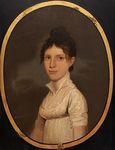About Face College of Wooster Art Museum, Fall 2021 - The College of Wooster
←
→
Page content transcription
If your browser does not render page correctly, please read the page content below
The Differences That Make Us
Imagine a world where everyone looked the same—how boring
and confusing would that be?! Luckily, we all have variations in
our features that makes each of us uniquely us!
Compare the features of 2 faces in the What is similar about these faces?
exhibition, or your face to the face on the What features are different?
cover of this booklet. Look at the shape, What do these differences and
hair, eyes, ears, nose, mouth, skin….. similarities tell you about each person?Face Detective
You can tell a lot about a person from their face!
Test your intuition and observations!
Choose an artwork you are curious about
How old do you think this person is? ________________
Enter Age Here
Circle the words that describe this person’s mood:
Angry Shy
Excited Worried
Surprised
Serious Sad
Other: __________________
Adjective
What do you
think the
person is
thinking
about?
Draw or write it
here.Low-level processing
When you first see a face, your brain gathers information
about simple lines and shapes. This is called low-level
processing!
This face by artist Henri Matisse is
a good example of the details
that low-level processing pays
attention to.
You can see a face, but you
might not be able to identify the
face as an individual. This is
because important information
about the details of the face is
missing.
Can you create a simple face
just using lines like Matisse? Try below!Super Senses
Faces are a major tool in identifying people as
individuals. But did you know many people are
unable to recognize faces? Instead, they must
rely on other ways to recognize their friends and
family.
Can you do the same? Complete the story
below to use your senses to identify someone
without looking at their face!
Without looking at their face, I know it is
_________________________________
Person’s name
They smell like ____________________
scent
Their voice is ________________________
Adjective (loud, sing-song, pretty, etc.)
Their hug is __________________________
Adjective (tight, warm, comforting, etc.)
They have _________________ hair
Length and color
Lastly, I know it’s them because they are
__________________________________
Favorite thing about themUniquely Human
Ever think about how animals don’t really make the same facial expressions as
humans? Some of this is because of muscles and facial structure. Animals more
closely related to us such as apes can display similar expressions such as smiling
while cats cannot.
Do you have a pet? How do they show what their mood is? Maybe you know your
dog is happy when they wag their tail. Write about what your pet does when they
are feeling happy, sad, scared, cuddly, below. (if you don’t have a pet describe
what you think your favorite animal would do!)
Draw your favorite animal making a funny faceThe A-MAZE-ing Brain
Make your way through the brain while learning about
different parts of the brain and their role in facial perception!
Red: Superior Temporal Sulcus (STS)- Processes information about where
someone is looking, helping us understand their emotions and what they
are looking at.
Blue: Lateral Occipital Cortex (LOC)- Processes objects by their individual
parts. This part of the brain allows you to understand that a face is made up
of two eyes, a nose, and a mouth.
Green: Fusiform Face area (FFA)- An area of the brain specialized in
recognizing all the parts (eyes, nose, and mouth) together (holistically) so
we can identify a person.
Fun Fact
A person can become so familiar with a certain kind of object
(like cars or dinosaurs for example) that they can holistically process
that type of object using their FFA.
This makes the person an “object expert”!Night at the CWAM
At the end of the day when everyone goes home, as the sun sets and the moon shines,
magic occurs at the museum and the art comes alive!
In the space below draw or write about what you think happens!
How do they interact? Do they talk to each other? What are they saying?
Cover image: William Paul Thomas, Big Paul, 2018. On loan from a private collection. © William Paul Thomas. Photograph courtesy of William Paul Thomas.
This guide was designed by Summer Research Assistant, Brianna Lyman, ‘23.You can also read



























































